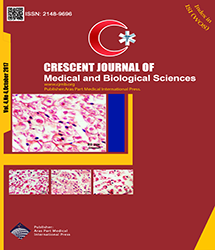
| Original Article | |
| Comparison of 2 Methods of Light Reduction on Preterm Infants" Sleep Pattern in NICU: A Randomized Controlled Trial | |
| Sousan Valizadeh1, Mohammadbagher Hosseini2, Mohammad Asghari Jafarabadi3, Kayvan Mirnia2, Farinaz Saeidi1, Mahnaz Jabraeeli1 | |
| 1Department of Pediatric, Nursing and Midwifery School, Tabriz University of Medical Sciences, Tabriz, Iran 2Pediatric Health Research Center, Tabriz University of Medical Sciences, Tabriz, Iran 3Department of Statistics and Epidemiology, Faculty of Health, Tabriz University of Medical Sciences, Tabriz, Iran |
|
|
CJMB 2017; 4: 211–216 Viewed : 7142 times Downloaded : 6203 times. Keywords : Preterm Infant, Sleep, Light reduction, Face cover |
|
| Full Text(PDF) | Related Articles | |
| Abstract | |
Objectives: Growth and development of preterm infants may be negatively affected by constant bright light in neonatal intensive care units ( NICUs ). It may also contribute to sleep pattern disorders commonly seen in in this group of infants. Reducing exposure to light by covering the incubators is recommended by guidelines of the Neonatal Individualized Developmental Care and Assessment Program (NIDCAP). Materials and Methods: This randomized clinical trial study was performed on 60 preterm infants with gestational age of 28-32 weeks admitted at NICU of Al-Zahra Teaching Hospital of Tabriz University of Medical Sciences in 2014. Preterm infants were divided randomly in 2 groups: In the first group (intervention), incubators were covered with a thick cover and the face was covered with a cloth (face cover). In the second group (observation), incubators were covered with a thick cover but the face was not covered. We darkened the environment of NICU by closing the curtain and turning off additional florescent lights from 19:30 pm till 7:30 am in both groups, then we compared sleep pattern in 2 groups of infants by using sleep diagram. Results: In the intervention group (face cover), the mean frequency of sleep during the 6 days increased by 2.96 times/observations and the mean amount of sleep increased by 59 minutes. Conclusion: This study showed that light reduction with incubator covers and eye shield, increases the frequency and sleep duration in premature infants. |
Cite By, Google Scholar
Google Scholar
PubMed
Online Submission System
 CJMB ENDNOTE ® Style
CJMB ENDNOTE ® Style
 Tutorials
Tutorials
 Publication Charge
Medical and Biological Research Center
About Journal
Publication Charge
Medical and Biological Research Center
About Journal
Aras Part Medical International Press Editor-in-Chief
Arash Khaki
Deputy Editor
Zafer Akan


















